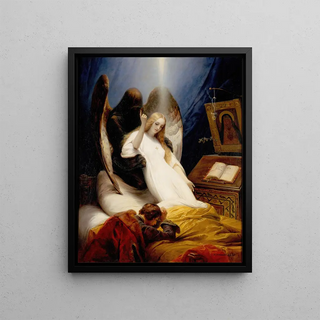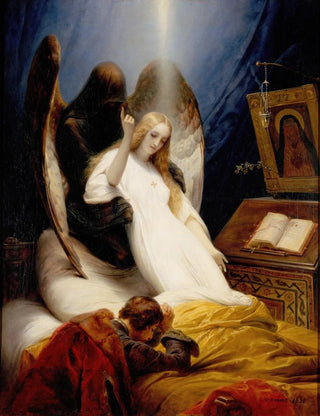Art print | Angel of Death - Horace Vernet


View from behind

Frame (optional)
In the fascinating world of art, certain works manage to capture the imagination in an indelible way. "Angel of Death" by Horace Vernet is a perfect example. This painting, both haunting and poetic, evokes universal themes such as mortality and transcendence. Vernet, master of dramatic representation, succeeds in creating an atmosphere charged with emotion, where the viewer is invited to contemplate the fragility of human existence. The art print of this iconic piece allows for an appreciation of the full depth of its message, while offering an immersion into the aesthetics of the 19th century.
Style and uniqueness of the work
The work "Angel of Death" stands out for its bold use of light and shadow, which imparts a dramatic intensity to the scene. Vernet skillfully plays with contrasts, creating chiaroscuro effects that highlight the presence of the angel, the central figure of the composition. The angel, both protector and harbinger of the end, is depicted with striking delicacy, its wings spread adding a spiritual dimension to the overall. The choice of colors, ranging from dark tones to lighter shades, reinforces the idea of a passage, a transition between the earthly world and the beyond. This stylistic singularity makes the work a true masterpiece, where pictorial technique harmonizes with a reflection on the human condition.
The artist and his influence
Horace Vernet, a French artist of the 19th century, is often associated with historical and military painting. His career, marked by a deep commitment to depicting epic scenes, demonstrates his talent for capturing moments of great intensity. Vernet established himself as an essential figure of his time, influencing many artists through his bold approach and technical mastery. His work "Angel of Death" fits within this lineage, but also reveals a more intimate sensitivity, an exploration of themes of life and death that resonate deeply with the viewer. Through his creations, Vernet not only enriched the French artistic heritage

Matte finish

View from behind

Frame (optional)
In the fascinating world of art, certain works manage to capture the imagination in an indelible way. "Angel of Death" by Horace Vernet is a perfect example. This painting, both haunting and poetic, evokes universal themes such as mortality and transcendence. Vernet, master of dramatic representation, succeeds in creating an atmosphere charged with emotion, where the viewer is invited to contemplate the fragility of human existence. The art print of this iconic piece allows for an appreciation of the full depth of its message, while offering an immersion into the aesthetics of the 19th century.
Style and uniqueness of the work
The work "Angel of Death" stands out for its bold use of light and shadow, which imparts a dramatic intensity to the scene. Vernet skillfully plays with contrasts, creating chiaroscuro effects that highlight the presence of the angel, the central figure of the composition. The angel, both protector and harbinger of the end, is depicted with striking delicacy, its wings spread adding a spiritual dimension to the overall. The choice of colors, ranging from dark tones to lighter shades, reinforces the idea of a passage, a transition between the earthly world and the beyond. This stylistic singularity makes the work a true masterpiece, where pictorial technique harmonizes with a reflection on the human condition.
The artist and his influence
Horace Vernet, a French artist of the 19th century, is often associated with historical and military painting. His career, marked by a deep commitment to depicting epic scenes, demonstrates his talent for capturing moments of great intensity. Vernet established himself as an essential figure of his time, influencing many artists through his bold approach and technical mastery. His work "Angel of Death" fits within this lineage, but also reveals a more intimate sensitivity, an exploration of themes of life and death that resonate deeply with the viewer. Through his creations, Vernet not only enriched the French artistic heritage






